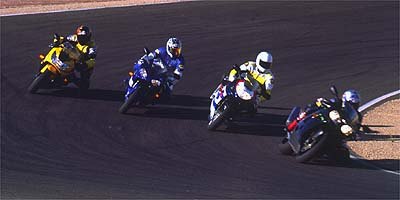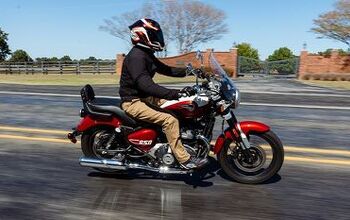
Get the Flash Player to see this player.
Thank you, may I have another?Disclaimer: By reading the following story you agree that you have no legal rights against motorcycle.com whatsoever. If you so much as think about duplicating any of the actions below, you are a bonehead...
Torrance, California, July 31, 2000 -- On this 31st day of July, MO does decree: "You can't own a motorcycle with too much power." So if you're one of those pansies that cowers at the thought of big-bore power, take off that skirt, strap yourself to a chair, and hang on while we convince you that nothing, and we mean nothing will rock your world like an Open Class motorcycle. You should own one, learn how to wheelie, do burnouts and run low 10-second quarter miles. Then you can be studly and have a nickname like "Minime", just like our very own Brent Avis, who penned most of this pundacious diatribe.
Indeed, think of the glory! Chicks will dig you, your friends will live in awe of you, and you're likely to have plenty of time in the local constabulatory's confines to reflect on deep thoughts such as power-to-weight ratios, and why you shouldn't really fear the brute force of 120+ bhp bikes.
It's a well-known fact that GP bikes generate an enormous amount of power in a manner that would scare the living begeezus out of a normal mammalian biped. Today's Open Class bikes may not make the same levels of power as a GP bike - in fact they fall far short - but they do have one advantage; they make flat, fun torque curves the whole family can enjoy.
Fourth Place: Kawasaki ZX-9RKawasaki's ZX-9R is, without a doubt, the best sport-touring bike here. With the most comfortable seat and riding position mated to VFR-style wind protection, there's no silkier ride here than Kawi's mill. With abundant amounts of bottom-end power and a longer wheelbase than anything else you see here, fast and unfamiliar roads are the domain where the Kawasaki longs to reside. And the occasional cross-country jaunt? Just make sure your gas card is paid up. It'll be a while before you feel like stopping.
When it comes to absolute stopping power, the Kawasaki's Tokiko binders are on par with the rest of the bikes here. The only problem with so much power is that it begs for acute control when it comes time to avoid particularly hairy situations like those often encountered on a racetrack. Some testers felt the Kawi's brakes lacked a bit in the way of feel that gets transferred from the pad/rotor interface to the fingertip/leather interface, occasionally putting a scary face on the rider's normally stoic face. Add to this a rude carburetion hiccup on/off throttle transitions and you need to max out your concentration level both going into and driving out of a corner, which makes the track more like work than fun.
The lap times might have been better yet, but the number three cylinder on the Kawi's motor stopped firing after a short time on the track. Just enough laps had passed to allow all testers to form an opinion of the bike, but not enough to allow them to dive deep into the recesses of the Kawi's bag of tricks to discover what might have allowed the 9R even quicker lap times. Kawasaki's rep canceled at the last minute, so kudos to Honda's Bob Oman for trying to fix the "competition".
The 929 is almost a joke in that it is laughably easy to maneuver. Manufacturers can tout "600-class size and feel" all they want, but of these four, only the Honda delivers on this tough-to-keep promise. You get propelled down the tarmac by a lively and smooth motor that is all too happy to provide you with a close-up look at the pixelation of the numbers on the tachometer as the front end lofts increasingly closer to your faceshield. The only problem with this is, of all the bikes, the 929 is the most willing to shake its head at you under large doses of throttle on rough pavement. On the street, this wasn't a big problem, but it has the potential to be when in the hands of the unskilled. This trait made itself especially known at the dragstrip where more than one run was completed with the bars wiggling side to side nearly the entire quarter mile.
On the tight Streets of Willow track, the 929 ground away at footpeg tabs more frequently than any bike on test here. It was not so much a problem as a nuisance that became a good laugh, dragging with regularity for the fast guys and even occasionally for those in our test crew with less prodigious amounts of talent. Still, no hard parts touched down on this or any of the bikes in the test.
Wind protection on the CBR is decent and the riding position is second only to that of the ZX-9R for street duty. For sport-touring chores, just a few clicks to soften the already-compliant suspension even further would be all it takes to make this bike a great choice for everyday use and occasional trackday tomfoolery.
Second Place: Suzuki GSX-R750Before you inquire as to what on earth a 750cc machine is doing walking away with runner-up honors in an open bike comparo, let us ask you: Have you ridden one of these things? Geez! The only thing missing is a two-stroke sound track playing in the back ground and an announcer with a cheezy English accent announcing your progress to the throngs of fans who have come to watch as you make short work of whatever road - or preferably track -lies before you. Where's Victory Lane, then? I want my trophy girls and champagne.
It must be said that, as a street bike, the GSX-R is no couch, or Kawasaki for that matter. The ergos feel like they were designed by Kevin Schwantz and, as such, place a majority of the rider's weight upon his hands and his butt in the air with feet not far below. If you're self-conscience abou the size of your (exposed) backside, this isn't the bike for you. You want ground clearance? You got it. You want revs and screeching high-rpm power? You got it here, too. A heaping helping of torque to go with that? Look elsewhere, buddy. What do you think this is, a Bandit 1200?
On the track, the Suzuki takes a bit of time to get up to speed. After stepping off any of the "true" open classers and taking off for some laps onboard the 750, you have to re-adjust your entire approach to
This Suzuki was never meant for street duty. Misano, yes. Manhattan to Milwaukee, no. The uncompromising ergos are barely tolerable on the street and, as such, make this a lackluster day-to-day bike. It can be fun on twisty roads, mind you, but you'll have to work very hard to get the most out of the machine. That's the trade-off Suzuki was willing to make, however. And what this bike has in track prowess more than makes up for all its streetworthy downfalls. You can't really expect a supermodel to do the dishes, too.
First Place: Yamaha YZF-R1Isn't it amazing that, with a completely new CBR929 and GSX-R750 thrown into the mix, an "old" bike like Yamaha's R1 could come out on top again? Just goes to show you how ahead of its time the bike was when it debuted a few years ago. It's so well-refined after its recent "sharpening" that it's almost boring in this company. It's not peaky or portly or twitchy. It just works. Everywhere. Painlessly.
The only reason the R1 might not be the best choice here is that you'll have to buy 20 valves instead of 16 if the motor ever takes a dump. It's a pretty flawless piece. The shifting isn't quite as smooth as the Honda's and, even though it weighs one pound less than the 929 despite having a larger displacement, the R1 felt a bit porkier to some testers. These are such minor niggles that they hardly seem worth mentioning.
On the road, the R1's wind protection isn't stellar, but it's not like riding on the tail of a Boeing 747, either. There's enough wind protection to keep loud complaints at bay since you wouldn't want to do anything to disrupt the beautiful styling on the front end of the machine, even if the front end is getting a little stale. The times, they are a changin', but the R1 still leads the way.
The Yamaha's lap times were consistently in the top two or three (switching spots with the Kawasaki all day depending on the rider). But even at those accelerated levels, the rider was having a lot more fun on the R1 and, street or track, isn't that what it's all about? Riders were so overwhelmed by the R1's goodness that every last one of them voted for the Yamaha to finish in the top spot.
ConclusionThe Yamaha provides unparalleled rider confidence and lets even slow riders feel fast and have fun. It's a good street bike and a great track bike that can seemingly do no wrong. The Honda is at least as good as a street bike but didn't quite perform as we'd hoped it would on the track. The twitchy front end was its biggest downfall, though a steering damper would be a quick fix that would keep most of the light steering intact.
The Suzuki, although it's pretty high strung for a street bike, is tolerable because it has such a playful and fun personality. Like a supermodel with an attitude, you put up with her at dinner just so you can get her into bed. Because it's such a phenomenal track bike - the best here - and is able to keep pace with bikes with far more displacement, it bumps the Honda down a notch.
As good as the Honda is among this group, falling just behind the Yamaha in almost every category, it gets bumped to third by a screamin' Suzuki. In spite of it being so high-strung, the GSX-R pops off all points of the brain that are responsible for everything from simple understanding to pornographic arousal. And all it takes is a little more work? Okay, then. We're happy to make that trade.

Motorcycle.com presents an unrivaled combination of bike reviews and news written by industry experts
More by Motorcycle.com Staff





































Comments
Join the conversation